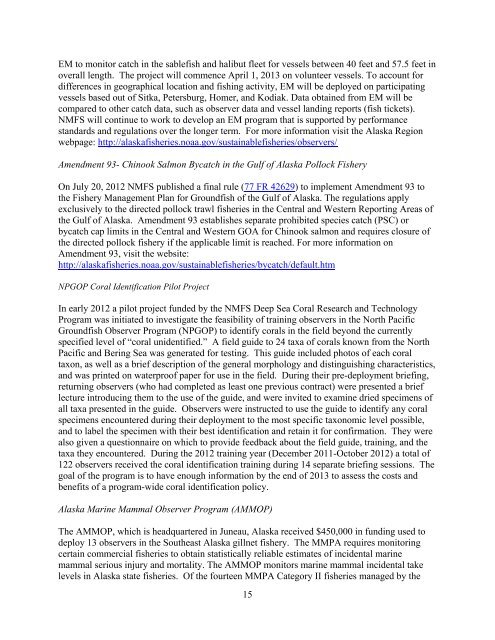National Observer Program Annual Report - Office of Science and ...
National Observer Program Annual Report - Office of Science and ...
National Observer Program Annual Report - Office of Science and ...
Create successful ePaper yourself
Turn your PDF publications into a flip-book with our unique Google optimized e-Paper software.
EM to monitor catch in the sablefish <strong>and</strong> halibut fleet for vessels between 40 feet <strong>and</strong> 57.5 feet in<br />
overall length. The project will commence April 1, 2013 on volunteer vessels. To account for<br />
differences in geographical location <strong>and</strong> fishing activity, EM will be deployed on participating<br />
vessels based out <strong>of</strong> Sitka, Petersburg, Homer, <strong>and</strong> Kodiak. Data obtained from EM will be<br />
compared to other catch data, such as observer data <strong>and</strong> vessel l<strong>and</strong>ing reports (fish tickets).<br />
NMFS will continue to work to develop an EM program that is supported by performance<br />
st<strong>and</strong>ards <strong>and</strong> regulations over the longer term. For more information visit the Alaska Region<br />
webpage: http://alaskafisheries.noaa.gov/sustainablefisheries/observers/<br />
Amendment 93- Chinook Salmon Bycatch in the Gulf <strong>of</strong> Alaska Pollock Fishery<br />
On July 20, 2012 NMFS published a final rule (77 FR 42629) to implement Amendment 93 to<br />
the Fishery Management Plan for Groundfish <strong>of</strong> the Gulf <strong>of</strong> Alaska. The regulations apply<br />
exclusively to the directed pollock trawl fisheries in the Central <strong>and</strong> Western <strong>Report</strong>ing Areas <strong>of</strong><br />
the Gulf <strong>of</strong> Alaska. Amendment 93 establishes separate prohibited species catch (PSC) or<br />
bycatch cap limits in the Central <strong>and</strong> Western GOA for Chinook salmon <strong>and</strong> requires closure <strong>of</strong><br />
the directed pollock fishery if the applicable limit is reached. For more information on<br />
Amendment 93, visit the website:<br />
http://alaskafisheries.noaa.gov/sustainablefisheries/bycatch/default.htm<br />
NPGOP Coral Identification Pilot Project<br />
In early 2012 a pilot project funded by the NMFS Deep Sea Coral Research <strong>and</strong> Technology<br />
<strong>Program</strong> was initiated to investigate the feasibility <strong>of</strong> training observers in the North Pacific<br />
Groundfish <strong>Observer</strong> <strong>Program</strong> (NPGOP) to identify corals in the field beyond the currently<br />
specified level <strong>of</strong> “coral unidentified.” A field guide to 24 taxa <strong>of</strong> corals known from the North<br />
Pacific <strong>and</strong> Bering Sea was generated for testing. This guide included photos <strong>of</strong> each coral<br />
taxon, as well as a brief description <strong>of</strong> the general morphology <strong>and</strong> distinguishing characteristics,<br />
<strong>and</strong> was printed on waterpro<strong>of</strong> paper for use in the field. During their pre-deployment briefing,<br />
returning observers (who had completed as least one previous contract) were presented a brief<br />
lecture introducing them to the use <strong>of</strong> the guide, <strong>and</strong> were invited to examine dried specimens <strong>of</strong><br />
all taxa presented in the guide. <strong>Observer</strong>s were instructed to use the guide to identify any coral<br />
specimens encountered during their deployment to the most specific taxonomic level possible,<br />
<strong>and</strong> to label the specimen with their best identification <strong>and</strong> retain it for confirmation. They were<br />
also given a questionnaire on which to provide feedback about the field guide, training, <strong>and</strong> the<br />
taxa they encountered. During the 2012 training year (December 2011-October 2012) a total <strong>of</strong><br />
122 observers received the coral identification training during 14 separate briefing sessions. The<br />
goal <strong>of</strong> the program is to have enough information by the end <strong>of</strong> 2013 to assess the costs <strong>and</strong><br />
benefits <strong>of</strong> a program-wide coral identification policy.<br />
Alaska Marine Mammal <strong>Observer</strong> <strong>Program</strong> (AMMOP)<br />
The AMMOP, which is headquartered in Juneau, Alaska received $450,000 in funding used to<br />
deploy 13 observers in the Southeast Alaska gillnet fishery. The MMPA requires monitoring<br />
certain commercial fisheries to obtain statistically reliable estimates <strong>of</strong> incidental marine<br />
mammal serious injury <strong>and</strong> mortality. The AMMOP monitors marine mammal incidental take<br />
levels in Alaska state fisheries. Of the fourteen MMPA Category II fisheries managed by the<br />
15

















